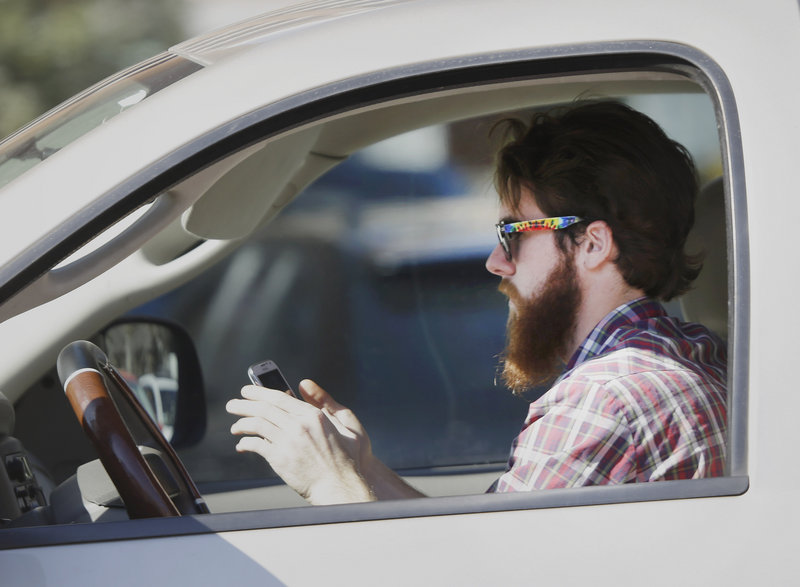NEW YORK – Texting while driving has become a greater hazard than drinking and driving among teenagers who openly acknowledge sending and reading text messages while behind the wheel of a moving vehicle.
The number of teenagers who are dying or being injured as a result of texting while driving has skyrocketed as mobile device technology has advanced. Researchers at Cohen Children’s Medical Center in New Hyde Park estimate more than 3,000 annual teen deaths nationwide from texting and 300,000 injuries.
The habit now surpasses the number of teenagers who drink and drive — a hazard that has been on a dramatic decline in recent years, researchers say.
An estimated 2,700 young people die each year as a result of driving under the influence of alcohol and 282,000 are treated in emergency rooms for injuries suffered in motor-vehicle crashes, according to the Centers for Disease Control and Prevention.
Dr. Andrew Adesman and a team of Cohen investigators found that between September 2010 and December 2011, among 8,947 teenagers age 15-18 nationwide, an estimated 49 percent of boys admitted to texting while driving compared with 45 percent of girls.
Texting also increased with age. Only 24 percent of 15-year-olds tapped out messages while driving, compared with 58 percent of 18-year-olds, the data showed. “A person who is texting can be as impaired as a driver who is legally drunk,” said Adesman, noting that a texting driver is distracted from the movement of traffic and the function of his or her own vehicle.
Data on texting and other instances of distracted driving in Maine is being collected on crash reports by Maine State Police and local police departments, according to Steve McCausland, spokesman for the Maine Department of Public Safety.
McCausland said the data, which was unavailable Thursday, has become particularly relevant since Maine adopted a texting ban in 2011. The state also enacted a distracted driving law in 2009.
Distracted driving may include texting or “it could be anything from eating a sandwich to putting your makeup on,” McCausland said.
There have been at least two and possibly three high-profile crashes in Maine involving drivers who were apparently texting or otherwise distracted, according to McCausland.
n Police allege that Kristina Lowe, 18 at the time, was texting, speeding and had been drinking and smoking marijuana when she crashed her car in West Paris in January 2012. The crash killed two passengers.
n State police said Heather Dawn Bouchard became distracted after dropping her cellphone on Interstate 295 in Yarmouth in April 2008. Bouchard’s car, which was heading south, crossed the median and hit a WCSH-TV van in the northbound lane operated by Channel 6 photojournalist Aaron Twombly and reporter Susan Kimball.
Twombly and Kimball were not seriously injured. Bouchard, 24, died at Maine Medical Center.
The new data are in sharp contrast to findings about drinking and driving among teenagers. The CDC reported last fall that alcohol use among teenage drivers has decreased by 54 percent since 1991.
Texting, however, has quickly grown in the last five to seven years, Adesman said.
“Fifty percent of high school students of driving age acknowledge texting while driving,” said Adesman, chief of developmental and behavioral pediatrics at Cohen.
“When we compared states where there are no laws in effect (barring texting while operating a moving vehicle) and states where there are laws on the books, we found there was no difference in their responses,” Adesman said. “Clearly, the laws are not effective.”
The National Highway Traffic Safety Administration acknowledged Wednesday that distracted driving of all kinds — including the use of handheld cellphones — is a growing hazard.
Agency officials describe texting as among the worst of driver distractions because conversing by text simultaneously involves manual, visual and mental distractions.
Observational surveys cited by the agency suggest more than 100,000 drivers are texting at any given daylight moment, while more than 600,000 drivers are using handheld phones while operating a car.
As an expert in teen behavior, Adesman puts texting while driving in the same risk category as other hazardous activities, such as lack of seat belt use; drinking and driving; binge drinking; drug and tobacco use; unsafe sex, and tanning devices.
“We have very strong taboos against drinking and driving. Kids don’t drink and drive every day. But some kids are out there texting and driving seven days a week — and they admit it,” Adesman said.
— Staff Writer Dennis Hoey contributed to this report.
Send questions/comments to the editors.


